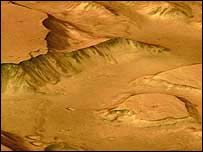Signs of gas on Mars: after water and remnants of a salty sea were discovered - now it's the turn of methane gas

Astronomers reported last night the discovery of methane in the atmosphere of Mars, which may indicate current volcanic activity on Mars or even bacterial activity on its surface. At this stage it is not possible to decide between these two possibilities, and so far neither volcanic activity nor bacterial activity has been discovered, but the news was published prominently.
The gas was detected using telescopes and the detection was supported by information obtained from instruments on board the European Mars Express spacecraft.
Methane breaks down very quickly in the Martian atmosphere and therefore it must be renewed in a constant supply, and according to the scientists this supply can come from volcanic eruptions or alternatively from bacterial activity.
Methane gas has been detected in the atmosphere of the planet Mars using telescopes on Earth and recently also by other means in space. According to scientists, its presence could indicate the existence of life on Mars.
According to the scientists, the molecules of methane gas must be renewed every few centuries to survive, indicating that the methane in the Martian atmosphere is renewed in some way. Renewal of methane gas is done through active volcanoes (so far not found on Mars) or through bacteria.
Bacteria produce methane from a combination of hydrogen and carbon dioxide. The bacteria on Earth that produce methane do not need oxygen to live, and scientists estimate that there is a chance that such bacteria live on the planet.
However, even if it turns out that the reason for the replenishment of the methane stock is volcanic activity, this may indicate the existence of life on the planet: the heat produced by the lava causes the ice layer to melt, which makes life possible on Mars.
The two space vehicles that landed on Mars in January of this year will not be able to answer the question of the source of the methane, as they were programmed for geological work only. However, future missions could include sensors that would be able to locate the source of the methane.
Another news on the same subject
Scientists at the American Space Agency (NASA) and the European Space Agency (ESA) have located important signs that may indicate the existence of life on Mars. Each of the groups independently discovered evidence of methane gas in the star's atmosphere. On Earth, methane is a waste product of organisms. It may also be a byproduct of bacteria that are under the surface of the "Red Planet" or of remnants of geological activity. The scientists who study the Martian atmosphere consider the detection of methane an important discovery, because the gas may provide unequivocal proof of the existence of life outside the Earth.
NASA and the European Space Agency have not officially published their findings, but experts who have seen the data believe that there is indeed methane on Mars; However, they do not see this as confirmation of the existence of life on the planet.
This discovery was revealed a few weeks after NASA and the European Space Agency announced new findings related to the presence of huge bodies of water on Mars, which would have been able to support life - if these had indeed developed.
The European research team is headed by Prof. Vittorio Formisano from the "Institute for Physics and Interstellar Science" in Rome, who operates the spectrometer to detect methane. The spectrometer (a device that measures wavelengths with which the composition of the gases in the Martian atmosphere can be identified) was found on the "Mars Express", which carried the European Space Agency's "Beagle-2" space vehicle that was lost on Mars. Mars Express is now in orbit around the star. "We can detect the presence of methane in the Martian atmosphere, and we were able to estimate how much there is there," said Professor Formisano.
According to him, "if methane exists on Mars it must have a source". According to him, there must be something that continues to produce it continuously, and explains: "The intense ultraviolet radiation on Mars consumes the methane, because it has a short photochemical lifetime - about 300 years."
The second group that detected signs of methane in the Martian atmosphere is headed by Dr. Michael Momma, from the NASA Space Flight Center in Maryland. Momma used powerful spectroscopic telescopes located on Earth. This group apparently also detected changes in methane concentrations, with the peak concentration found in the ancient seabed of the "Meridian" plain, which was explored by NASA's "Opportunity" space vehicle. Last week, NASA reported that Opportunity had discovered what used to be a salty sea on Mars. Opportunity may be able to indicate an underground source of methane resulting from the remains of geological activity, or from the presence of living organisms that produce it as waste.
If volcanic activity is the cause of methane formation, this would be a discovery with important implications. The heat released by volcanic activity would have melted the amounts of ice that were discovered below the surface, creating an environment suitable for life. However, so far no centers of volcanic activity have been located.
Dr. Momma was asked if the continuous production of methane is evidence of a biological origin, and replied: "I think so. It is hard to imagine that primordial methane from geological activity will continue to be emitted for four billion years - the age of Mars."
The two teams of scientists are now busy confirming the results before the space agencies speak publicly about the implications of the findings. Colin Pillinger, the chief scientist of Beagle-2, said: "The discovery may be evidence of life in the past, and maybe even in the present."
